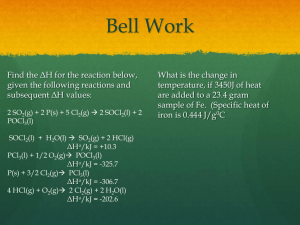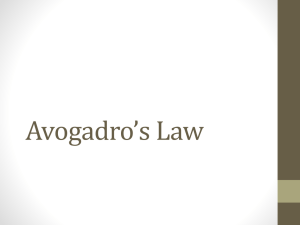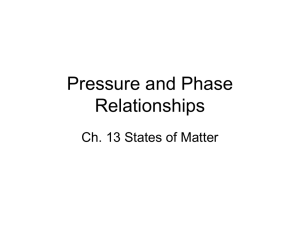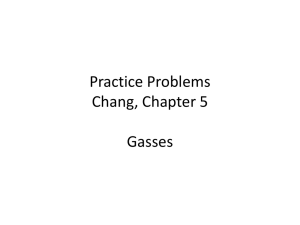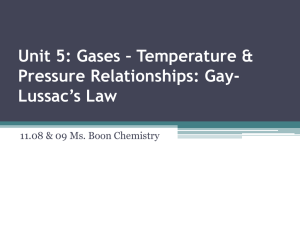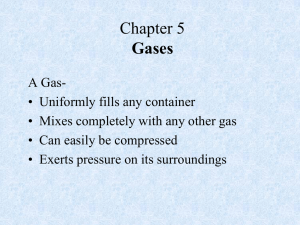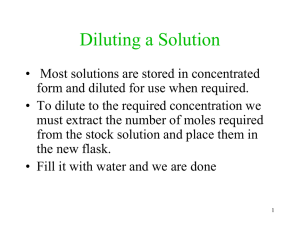Patino-CHM2045C-Chapter12
advertisement
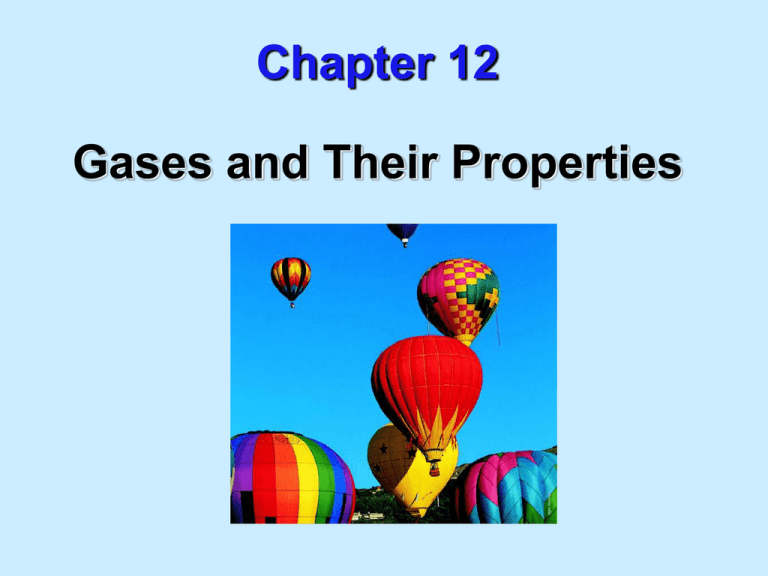
Chapter 12 Gases and Their Properties Chapter Goals • • • • • Understand the basis of the gas laws and know how to use those laws (Boyle’s law, Charles’ law, Avogadro’s hypothesis, Dalton’s law). Use the (model) ideal gas law. Apply the gas laws to stoichiometric calculations. Understand kinetic-molecular theory as it is applied to gases, especially the distribution of molecular speeds (energies). Recognize why real gases do not behave like ideal gases. Gases in Earth Eleven elements are gases under normal conditions: five diatomic, H2, N2, O2, F2, Cl2, and the six monatomic noble gases, He, Ne, Ar, Kr, Xe, Rn. The thickness of the atmosphere is ~ 1/250 the diameter of the Earth. Yet this delicate layer is vital for our life. It shields us from harmful radiation and supplies substances needed for life, such as oxygen, nitrogen, carbon dioxide, and water. Composition of the Atmosphere and Some Common Properties of Gases Composition of Dry Air Gas N2 O2 Ar CO2 He, Ne, Kr, Xe CH4 H2 % by Volume 78.09 20.94 0.93 0.03 0.002 0.00015 0.00005 Comparison of Solids, Liquids, and gases The density of gases is much less than that of solids or liquids. Density Solid Liquid Gas (g/mL) H2O 0.917 0.998 0.000588 CCl4 1.70 1.59 0.00503 Gas molecules must be very far apart compared to liquids and solids. General Properties of Gases • There is a lot of “free” space in a gas. • Gases can be expanded infinitely. • Gases occupy containers uniformly and completely. • Gases diffuse and mix rapidly. Importance of Gases Airbags fill with N2 gas in an accident. Gas is generated by the decomposition of sodium azide, NaN3. 2 NaN3(s) 2 Na(s) + 3 N2(g) Properties of Gases Gas properties can be modeled using math. Model depends on four quantities (parameters): V = volume of the gas (L) T = temperature (K) n = amount (moles) P = pressure (atmospheres) Pressure Pressure is force per unit area. force F Pressure = ──── P = ── area A N SI unit: pascal, 1 Pa = ─── = 1kgm−1s−2 m2 Pressure Atmospheric pressure (pressure of the atmosphere) is measured with a barometer, invented by Torricelli (1643). Definitions of standard pressure 76 cm Hg = = 760 mm Hg = 760 torr = = 1 atmosphere = 1 atm 1 atm = 101.3 kPa = 1.013 105 Pa = = 14.7 psi (pounds per square inch) 1 bar = 1105 Pa = 0.987 atm 1 atm = 14.7 psi H2O density ~ 1 g/mL Hg density = 13.6 g/mL Pressure Unit Conversions Now we can use pressure units as conversion factors Convert 202.6 kPa to Hg mm, bars, and atm. 760 Hg mm 202.6 kPa ──────── = 1520 Hg mm 101.3 kPa 103 Pa 1 bar 202.6 kPa ───── ───── = 2.026 bar 1 kPa 105 Pa 1 atm 202.6 kPa ────── = 2.000 atm 101.3 kPa Example – A high-performance bicycle tire has a pressure of 132 psi. What is the pressure in mmHg? Given: Find: Concept Plan: 132 psi mmHg psi atm 1 atm 14.7 psi Relationships: mmHg 760 mmHg 1 atm 1 atm = 14.7 psi, 1 atm = 760 mmHg Solution: 1 atm 760 mmHg 132 psi 6.82103 mmHg 14.7psi 1 atm Check: since mmHg are smaller than psi, the answer makes sense Manometers • the pressure of a gas trapped in a container can be measured with an instrument called a manometer • manometers are U-shaped tubes, partially filled with a liquid, connected to the gas sample on one side and open to the air on the other • a competition is established between the pressure of the atmosphere and the gas • the difference in the liquid levels is a measure of the difference in pressure between the gas and the atmosphere Manometer for this sample, the gas has a larger pressure than the atmosphere, so Pressure gas Pressure atmosp here Pressure h Pressure gas (mmHg) Pressure atmosp here (mmHg) difference in Hg levels (mm) IDEAL GAS LAW P V = n R T Brings together gas properties. Can be derived from experiment and theory. Boyle’s Law If n and T are constant, then PV = k (constant) This means, for example, that P goes up as V goes down. A bicycle pump is a good example of Boyle’s law. As the volume of the air trapped in the pump is reduced, its pressure goes up, and air is forced into the tire. Robert Boyle (1627-1691). Boyle’s Law: The Volume-Pressure Relationship PV = k (hyperbola) V 1 or V= k ── or V 1/P P 1/P P1V1 = k1 for one sample of a gas. P2V2 = k2 for a second sample of a gas. k1 = k2 for the same sample of a gas (same number of moles at the same T.) Thus we can write Boyle’s Law mathematically as P1V1 = P2V2 for constant n and T Boyle’s Law: The Volume-Pressure Relationship Example: At 25oC a sample of He has a volume of 4.00 x 102 mL under a pressure of 7.60 x 102 torr. What volume would it occupy under a pressure of 2.00 atm at the same T? Firstly, we need to convert atm to torr: 760 torr P1 V1 P2 V2 2.00 atm───── = P1 V1 1 atm V 2 = 1520 torr Then, using Boyle’s law P2 760 torr400 mL 1520 torr 2.00 102 mL Boyle’s Law: The Volume-Pressure Relationship • Notice that in Boyle’s law we can use any pressure or volume units as long as we consistently use the same units for both P1 and P2 or V1 and V2. • Use your intuition to help you decide if the volume will go up or down as the pressure is changed and vice versa. Charles’s Law If n and P are constant, then V = kT V and T are directly related (proportional.) Jacques Charles (1746-1823). Isolated boron and studied gases. Balloonist. Charles’ Law: The Volume-Temperature Relationship; The Absolute Temperature Scale 35 30 25 Volume (L) vs. Temperature (K) 20 15 Gases liquefy before reaching 0 K 10 5 This part is extrapolated 0 0 50 100 150 200 250 absolute zero = −273.15 0C 300 350 400 Charles’ Law: The Volume-Temperature Relationship; The Absolute Temperature Scale Charles’s law states that the volume of a gas is directly proportional to the absolute temperature at constant pressure. Gas laws must use the Kelvin scale to be correct. Relationship between Kelvin and centigrade. K = °C + 273.15 Charles’ Law: The Volume-Temperature Relationship Mathematical form of Charles’ law. V V T or V = k T or ── = k n & P const T V1 ── = k T1 V1 V2 ── = ── T1 T2 and V2 ── = k T2 in the most useful form Charles’ Law: Example: A sample of hydrogen, H2, occupies 1.00 x 102 mL at 25.0oC and 1.00 atm. What volume would it occupy at 50.0oC under the same pressure? T1 = 25 + 273 = 298 T2 = 50 + 273 = 323 V1 V2 ── = ── T1 T2 V1 T2 V2 = ──── T1 1.00 x 102 mL 323 K V2 = ───────────── = 108 mL 298 K Standard Temperature and Pressure Standard temperature and pressure is given the symbol STP. It is a reference point for some gas calculations. Standard P 1.00000 atm or 101.3 kPa Standard T 273.15 K or 0.00 oC Avogadro’s Hypothesis Avogadro’s Hypothesis states that at the same T and P, equal volumes of two gases contain the same number of molecules (or moles) of gas. V = k n n = moles k = const. On those basis, the following equation means 2 H2(g) + O2(g) 2 H2O(g) 2 moles H2 reacts with 1 mole of O2 to produce 2 moles H2O ratios 2 : 1 : 2 2 L of H2 reacts with 1 L of O2 to produce 2 L of H2O or 8 volumes + 4 volumes 8 volumes (H2O) 8 = 2x4 Here, volume means any unit (mL or L). Gases in this experiment are measured at same T & P. Avogadro’s Hypothesis and the Standard Molar Volume Avogadro’s Hypothesis states that at the same temperature and pressure, equal volumes of two gases contain the same number of molecules (or moles) of gas. If we set the temperature and pressure for any gas to be STP, then one mole of that gas has a volume called the standard molar volume. * The standard molar volume is 22.4 L at STP. This is another way to measure moles. For gases, the volume is proportional to the number of moles. V = k n 11.2 L of a gas at STP = 0.500 mole 44.8 L = ? moles Avogadro’s Hypothesis and the Standard Molar Volume Example: One mole of a gas occupies 36.5 L and its density is 1.36 g/L at a given temperature and pressure. (a) What is its molar mass? (b) What is its density at STP? ? g 365 . L 136 . g 49.6 g / mol mol mol L ?g 49.6 g 1 mol 2.21g/L LSTP mol 22.4 L The Combined Gas Law Equation Boyle’s and Charles’ Laws combined into one statement that is called the combined gas law equation. Useful when the V, T, and P of a gas are changing, but n is constant. Boyle's Law P1V1 P2 V2 Charles'Law V1 V2 T1 T2 For a given sampleof gas : T hecombinedgas law is : PV k T P1 V1 P2 V2 T1 T2 The Combined Gas Law Equation Example: A sample of nitrogen gas, N2, occupies 7.50 x 102 mL at 75.00C under a pressure of 8.10 x 102 torr. What volume would it occupy at STP? V1 = 750 mL T1 = 348 K P1 = 810 t orr V2 = ? T2 = 273K P2 = 760 t orr P1 V1 T2 Solve for V2 = P2 T1 810 t orr750 mL273K 760 t orr348 K 627 mL The Combined Gas Law Equation Example: A sample of methane, CH4, occupies 2.60 x 102 mL at 32oC under a pressure of 0.500 atm. At what temperature would it occupy 5.00 x 102 mL under a pressure of 1.20 x 103 torr? V1 = 260 mL V2 = 500 mL P1 = 0.500at m P2 = 1200 t orr = 380 t orr T1 = 305 K T2 = ? T1 P2 V2 305 K 1200 t orr500 mL T2 = 380 t orr260 mL P1 V1 = 1852K 1580o C Summary of Gas Laws: The Ideal Gas Law • Boyle’s Law − V 1/P (at constant T & n) • Charles’ Law – V T (at constant P & n) • Avogadro’s Law – V n (at constant T & P) Combine these three laws into one statement V nT/P Convert the proportionality into an equality. nRT V = ───── P This provides the Ideal Gas Law PV = nRT R is a proportionality constant called the universal gas constant. Summary of Gas Laws: The Ideal Gas Law We must determine the value of R. Recognize that for one mole of a gas at 1.00 atm, and 273 K (STP), the volume is 22.4 L. Use these values in the ideal gas law. PV 1.00 atm 22.4 L R = nT 1.00 mol 273 K L atm 0.0821 mol K Summary of Gas Laws: The Ideal Gas Law R has other values if the units are changed. • R = 8.314 J/mol K Use this value in thermodynamics. • R = 8.314 kg m2/s2 K mol Use this later in this chapter for gas velocities. • R = 8.314 dm3 kPa/K mol This is R in all metric units. • R = 1.987 cal/K mol This is the value of R in calories rather than J. Using PV = nRT What volume would 50.0 g of ethane, C2H6, occupy at 140 oC under a pressure of 1.82 x 103 torr? T = 140 + 273 = 413 K 1 atm P = 1820 torr ────── = 2.39 atm 1 mol 760 torr n = 50.0 g ───── = 1.67 mol 30.0 g PV = n RT nRT V= P L at m 1.67 mol 0.0821 413K mol K 2.39 at m 23.6 L Using PV = nRT Calculate the pressure exerted by 50.0 g of ethane, C2H6, in a 25.0 L container at 25.0oC. MW = 30.07 g/mol n = 1.67 moland T = 298 K nRT P= V L at m 1.67mol 0.0821 298 K mol K P 25.0L P 1.63 at m A flying balloon contains 1.2x107 L of He at a pressure of 737 mm Hg and 25 °C. What mass of He does the balloon contain? A.W. He = 4.00g/mol 1 atm 737 mm Hg ─────── = 0.970 atm 760 mm Hg PV=nRT m P V = ── R T M PVM 0.970 atm 1.2x107 L 4.00g/mol m = ──── = ─────────────────────── RT 0.0821 atm L/K mol 298 K m = 1.9 106 g Determination of Molecular Weights and Molecular Formulas of Gaseous Substances Example: A gaseous compound is 80.0% carbon and 20.0% hydrogen by mass. At STP, 546 mL of the gas has a mass of 0.732 g. What is its molecular formula? 100 g of compound contains 80 g of C and 20 g of H. 1 molC ? molC atoms= 80.0g C 6.67 molC 12.0g C 1 mol H ? mol H atoms= 20.0g H 19.8 mol H 1.01g H Determinethesmallest whole number ratio. 19.8 3 theempiricalformulais CH 3 with mass = 15 6.67 Determination of Molecular Weights and Molecular Formulas of Gaseous Substances Example: At STP, 546 mL of the gas has a mass of 0.732 g. Now, we can calculate the molar mass (M) of the compound: m(g) m mRT PV = nRT, n = ───, PV = ── RT, M = ───── M M PV 0.732 g 0.0821 Latm/molK 273 K g M = ─────────────────────── = 30.0─── 1.00 atm 0.546 L mol M 30.0 ─── = ─── = 2 W EF 15.0 Then, 2 CH3 = C2H6, the formula. The Density of Gases and Molar Mass As previously said, density of a gas is given in g/L. Calculate the density of methane, CH4, at 37 °C and a pressure of 1.50 atm. He m(g) mRT PV = nRT, n = ─── , PV = ───── M M m PM d = ──= ─── V RT M(CH4) = 12.01 + 41.008 = 16.04 g/mol T = 37 + 273 = 310. K 1.50 atm 16.04 g/mol g d = ────────────────── = 0.945 ─── 0.0821 Latm/molK 310. K L The Density of Gases and Molar Mass The density of a gas is 0.391 g/L at 70.5 torr and 22.3 °C. Calculate its molar mass (M). T = 22.3 + 273.15 = 295.4 K 1 atm P = 70.5 torr ─────── = 0.0928 atm 760 torr PM d = ─── RT dRT Then, M = ──── P 0.391 g/L0.0821 Latm/molK 295.4K g M = ──────────────────────── = 102 ─── 0.0928 atm mol Mass-Volume Relationships in Reactions Involving Gases • In this section we are looking at reaction stoichiometry, like in Chapter 4, just including gases in the calculations. MnO 2 & 2 KClO3(s) 2 KCl(s) + 3 O2(g) 2 mol KClO3 yields 2 mol KCl and 3 mol O2 2(122.6g) yields 2 (74.6g) and 3 (32.0g) Those 3 moles of O2 can also be thought of as: 3(22.4L) or 67.2 L at STP What volume of oxygen measured at STP, can be produced by the thermal decomposition of 120.0 g of KClO3? FW (KClO3) = 122.6 g/mol MnO 2 & 2 KClO3(s) 2 KCl(s) + 3 O2(g) ? LSTP 1 mol KClO3 22.4 LSTP O 2 3 molO 2 O 2 120.0g KClO3 122.6g KClO3 2 mol KClO3 1 molO 2 ? LSTP O 2 32.9 LSTP O 2 31. Iron reacts with HCl(aq) to produce iron (II) chloride and hydrogen gas. The gas from the reaction of 2.2 g Fe with excess acid is collected in a 10.0 L flask at 25 °C. What is the H2 pressure? Fe(s) + 2 HCl(aq) FeCl2(aq) + H2(g) 1 mol Fe 1 mol H2 2.2 g Fe ────── ────── = 0.039 mol H2 55.85 g Fe 1 mol Fe PV=nRT nRT P = ──── V 0.039 mol 0.0821 atm L/K mol 298 K P = ──────────────────────── = 0.095 atm 10.0 L Gases Laws and Chemical Reactions Bombardier beetle uses decomposition of hydrogen peroxide to defend itself. 2 H2O2(liq) 2 H2O(g) + O2(g) Decompose 1.1 g of H2O2 in a flask with volume of 2.50 L. What is the pressure of O2 at 127 oC? Of H2O? M(H2O2) = 34.0 g/mol Firstly, calculate moles of H2O2 and O2: 1 mol H2O2 1 mol O2 1.1 g H2O2──────── ─────── = 0.016 mol O2 34.0 g H2O2 2 mol H2O2 Gases Laws and Chemical Reactions 2 H2O2(liq) 2 H2O(g) + O2(g) Now, with the moles of O2 we calculate P of O2 n R T 0.016 mol 0.0821 400 K P=──── = ───────────────── = 0.21 atm O2 V 2.50 L We can calculate moles and P of H2O or just, because the coefficient of H2O is 2 and O2’s is one, moles and P of H2O are the double of O2’s. H2O, n = 0.032 mol P = 0.42 atm Dalton’s Law of Partial Pressures For the reaction 2 H2O2(liq) 2 H2O(g) + O2(g) final pressures are: 0.42 atm 0.21 atm They are said to be partial pressures of H2O and O2. What is the total pressure in the flask? Ptotal in gas mixture = PA + PB + … Therefore, Ptotal = P(H2O) + P(O2) = 0.42 + 0.21 = 0.63 atm Example of Dalton’s Law, Ptotal = Σ(partial pressures) holds at constant volume and temperature. Each gas occupies the whole volume regardless of other. Dalton’s Law of Partial Pressures John Dalton 1766-1844 Dalton’s Law of Partial Pressures Vapor Pressure of a liquid is the pressure exerted by a substance’s vapor over the substance’s liquid at equilibrium. Dalton’s Law of Partial Pressures Zn + HCl(aq) ZnCl2(aq) + H2(g) Patm = PH2 + P H2O Dalton’s Law of Partial Pressures Example: A sample of hydrogen was collected by displacement of water at 25.0 oC. The atmospheric (barometric) pressure was 748 torr. What pressure would the dry hydrogen exert in the same container? Ptotal = P(H2) + P(H2O) P(H2) = Ptotal – P(H2O) P(H2O) = 24 torr (taken from tables) at 25.0 °C P(H2) = (748 – 24) torr = 724 torr Dalton’s Law of Partial Pressures A sample of oxygen was collected by displacement of water. The oxygen occupied 742 mL at 27.0 oC. The barometric pressure was 753 torr. What volume would the dry oxygen occupy at STP? P(H2O) = 27 torr (taken from tables) at 27.0 °C Use combined gas law as all parameters changed. V1 742 mL V2 ? T1 300 K T2 273 K P1 753 27 = 726 torr P2 760 torr 273 K 726 torr V2 742 mL 645 mL @ STP 300 K 760 torr Total P, Partial Pressures, and Mole Fraction For a mixture of several gases (A, B, C, …) nA R T nB R T nC R T PT = PA + PB + PC + … = ──── + ──── + ──── + … V V V (nA+ nB + nC)R T ni RT PT = ─────────── Pi = ──── i = A, B, C, … V V There is a simple relation between every Pi and PT Total P, Partial Pressures, and Mole Fraction nA R T ──── PA V nA nA XA= ── = ───────────── = ────────── = ── PT (nA+ nB + nC + )R T nA+ nB + nC + nT ───────────── V XA is the mole fraction of A, ratio of moles of A to the total, or ratio of partial pressure to total pressure nA nB nC XA + XB + XC + = ─── + ─── + ─── + nT nT nT nA + nB + nC + Pi XA + XB + XC + = ─────────── = ── = 1 nT PT They add up to one A 5.25 L sample of argon was collected over water at 30 °C and at a pressure of 830.0 torr. What were the mole fractions of Ar and water? Vapor pressure of H2O is 31.8 torr at 30 °C. PT = PAr + PW PAr = PT − PW W = water PAr = (830.0 – 31.8) = 798.2 torr PAr 798.2 torr XAr = ─── = ─────── = 0.9617 (no units) PT 830.0 torr XAr + XW = 1 XW = 1 – XAr = 1 – 0.9617 = 0.0383 We didn’t use V and T. We didn’t need them. Dalton’s Law of Partial Pressures If 1.00 x 102 mL of hydrogen, measured at 25.0 oC and 3.00 atm pressure, and 1.00 x 102 mL of oxygen, measured at 25.0 oC and 2.00 atm pressure, were forced into one of the containers at 25.0 oC, what would be the pressure of the mixture of gases? V and T of the two gases are the same: the Ps won’t change PTotal PH 2 PO 2 3.00 atm + 2.00 atm = 5.00 atm What is the mol fraction of each gas in the mixture? P(H2) 3.00 atm X(H2)=──── = ────── = 0.600 PT 5.00 atm X(O2) = 1 – 0.600 = 0.400 Dalton’s Law of Partial Pressures 10.0 g of argon and 20.0 g of Ne are placed in a closed container at 25.0 oC and the pressure of the mixture is 25.5 atm. What is the partial pressure of Ne in the mixture? We need to calculate the moles of the two gases and, then, the mole fraction and partial pressure of Ne. Moles: Ne, 20.0/20.179 = 0.991 mole Ar, 10.0/39.948 = 0.250 mole nNe 0.991 mole XNe = ─── = ──────── = 0.799 nT 1.241 mole PNe XNe= ─── PT PNe = XNe × PT = 0.799 × 25.5 atm = 20.4 atm KINETIC MOLECULAR THEORY (KMT) Theory used to explain gas laws. KMT assumptions are • Gases consist of molecules in constant, random motion. • P arises from collisions with container walls. • No attractive or repulsive forces between molecules. Collisions elastic. • Volume of molecules is negligible, compared to the V of container. Kinetic Molecular Theory Because we assume molecules are in motion, they have a kinetic energy. Average for 1 mole m: mass of a single molecule m u2 M u2 KE = ──── u = speed KE = ──── 2 2 At the same T, all gases have the same average KE. 3 KE = ── RT (for 1 mol of gas) 2 KE and T are directly proportional As T goes up for a gas, KE also increases — and so does speed. Kinetic Molecular Theory At the same T, all gases have the same average KE. As T goes up, KE also increases — and so does speed. Kinetic Molecular Theory Maxwell’s equation urms = u2 3RT M root mean square speed where u is the speed and M is the molar mass. • speed INCREASES with T • speed DECREASES with M Kinetic Molecular Theory Example: What is the 2 kg m root mean square 3 8.314 2 298 K sec K mol speed of N2 molecules u rms o 0.028 kg / mol at room T, 25.0 C? kg m2 R = 8.314 ─────── s2 K mol What is the root mean square velocity of He atoms at room T, 25.0oC? 515 m / s = 1159 mi / hr M in kg kg m 2 3 8.314 2 298 K sec K mol u rms 0.004 kg / mol 1363 m / s = 3067 mi / hr Distribution of Gas Molecule Speeds •Boltzmann plots •Named for Ludwig Boltzmann, Scot Physicist who also developed the theory of electromagnetic radiation (1864.) Velocity of Gas Molecules Molecules of a given gas have a range of speeds. Velocity of Gas Molecules Average velocity decreases with increasing mass, at the same Temperature 3 RT urms = √ ──── M GAS DIFFUSION AND EFFUSION DIFFUSION is the gradual mixing of molecules of different gases. Air Br2 GAS EFFUSION EFFUSION is the movement of molecules through a small hole (pinhole) into an empty container. GAS DIFFUSION AND EFFUSION Molecules effuse thru holes in a rubber balloon (pinholes), for example, at a rate (= moles/time) that is • proportional to T • inversely proportional to M. Therefore, He effuses more rapidly than O2 at same T. He GAS DIFFUSION AND EFFUSION Graham’s law governs effusion and diffusion of gas molecules. Rate for A Rate for B M of B M of A Rate of effusion is inversely proportional to its molar mass. Thomas Graham, 1805-1869. Professor in Glasgow and London. GAS DIFFUSION AND EFFUSION • Calculate the ratio of the rate of effusion of He to that of sulfur dioxide, SO2, at the same temperature and pressure. R He R SO 2 M SO 2 M He 641 . g / mol 4.0 g / mol 16 4 R He 4 R SO 2 GAS DIFFUSION AND EFFUSION A sample of hydrogen, H2, was found to effuse through a pinhole 5.2 times as rapidly as the same volume of unknown gas (at the same temperature and pressure). What is the molecular weight of the unknown gas? R H2 R unk 5.2 M unk M H2 M unk 2.0 g/mol M unk 27 2.0 g/mol M unk 27( 2.0 g/mol)= 54 g/mol GAS DIFFUSION AND EFFUSION Examples of relationships: Gas A effuses (or diffuses) 5.2 times faster than gas B rate A MB ───── = 5.2 = SQRT( ────) rate B MA Gas A effuses at half of the speed of gas B rate A 1 ───── = ── = 0.5 rate B 2 Gas A takes a time the triple it takes to gas B to diffuse: the more time it takes the slower the gas is. rate A 1 ───── = ── rate B 3 Gas Diffusion relation of mass to rate of diffusion Active Figure 12.18 • HCl and NH3 diffuse from opposite ends of tube. • Gases meet to form NH4Cl • HCl heavier than NH3 • Therefore, NH4Cl forms closer to HCl end of tube. Chapter 12 # 102 Each four tires of a car is filled with a different gas. Each tire has the same V, and each is filled to the same P, 3.00 atm, and 25.0 °C. One contains 116.0 g air, another 80.7 g Ne, the third 16.0 g He, and the forth has 160.0 g of an unknown gas. a) # of molecules? All tires contain the same number of molecules, because they have the same volume, T, and P. PV n = ──── RT # of molecules are moles (n) x 6.02 x 1023 Chapter 12 # 102 b) Molar mass of unknown gas? Due to fact that all gases have the same number of molecules, the ratio of their masses corresponds to the ratio of the molar masses, because n(moles) is the same. The difference in the masses is due to their molar masses: A.W. He = 4.0 g/mol molar mass unknown 160.0 g ────────────── = ───── = 10.0 times heavier x 4.0 = 40.0 molar mass He 16.0 c) Highest average speed? According to the KE = 3/2 RT, all gases have the same kinetic energy at the same temperature, but the average speed depends on their molar masses. According to 3RT u = SQRT (────) rms M The gas with the lowest M will have the highest speed, i.e., He. Using KMT to Understand Gas Laws Recall that KMT assumptions are • Gases consist of molecules in constant, random motion. • P arises from collisions with container walls. • No attractive or repulsive forces between molecules. Collisions elastic. • Volume of molecules is negligible, compared to the V of container. Avogadro’s Hypothesis and Kinetic Molecular Theory nRT P = ——— V P proportional to n — when V and T are constant Gas Pressure, Temperature, and Kinetic Molecular Theory nRT P = ——— V P proportional to T — when n and V are constant Boyle’s Law (look @ notes) and Kinetic Molecular Theory nRT P = ——— V P proportional to 1/V — when n and T are constant Deviations from Ideal Gas Law • Real molecules have volume. • There are intermolecular attractive forces. –Otherwise a gas could not become a liquid. Deviations from Ideal Gas Law Account for volume of molecules and intermolecular forces with VAN DER WAALS’s EQUATION. Measured V = V(ideal) Measured P ( P 2 n a + ----2 V ) V - nb nRT vol. correction intermol. forces J. van der Waals, 1837-1923, Professor of Physics, Amsterdam. Nobel Prize 1910. Deviations from Ideal Gas Law Cl2 gas has a = 6.49, b = 0.0562 For 8.0 mol Cl2 in a 4.0 L tank at 27 oC. nRT 8.0 0.0821 300 P(ideal) =─── = ──────────── = 49.3 atm V 4.0 P (van der Waals) = 29.5 atm Deviations from Ideal Gas Law • Calculate the pressure exerted by 84.0 g of ammonia, NH3, in a 5.00 L container at 200. oC using the ideal gas law. 1 mol n = 84.0g NH3 4.94 mol 17.0g L at m 4.94 mol 0.0821 473K nRT mol K P= V 5.00L P 38.4 at m Deviations from Ideal Gas Law • Solve of ammonia using the van der Waal’s equation. • P=? 84.0 g of NH3, in a 5.00 L container at 200. oC. L2 at m L n = 4.94mol a = 4.17 b = 0.0371 mol mol2 n 2a P + 2 V - nb nRT V nRT n 2 a P= 2 V - nb V 2 4 . 94 mol 4.17 Lmolatm 4.94 mol 0.0821 473K P L 5.00 L (4.94 mol)(0.0371mol ) 5.00 L2 L atm mol K 191.8 L atm P 4.07 atm (39.8 atm 4.1 atm) 4.817 L P 35.7 atm which is a 7.6%differencefromideal 2 2

